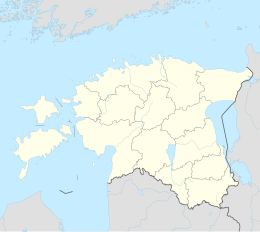Püssi
| Püssi | |||
|
|||
| State : |
|
||
| Circle : |
|
||
| Founded : | 1993 (city rights) | ||
| Coordinates : | 59 ° 22 ′ N , 27 ° 3 ′ E | ||
| Area : | 2.1 km² | ||
| Residents : | 1,212 (01/01/2013) | ||
| Population density : | 577 inhabitants per km² | ||
| Time zone : | EET (UTC + 2) | ||
| Telephone code : | (+372) 033 | ||
| Postal code : | 43222 | ||
| Community type: | city | ||
| Mayor : | Enno Mägar
( IRL ) |
||
| Postal address : | Viru 3 43222 Püssi |
||
| Website : | |||
|
|
|||
Püssi (historical German name Neu-Isenhof ) is a city in northeast Estonia . Until 2013 it was an independent municipality, since then it has been part of the rural municipality of Lüganuse .
Location and population
Püssi is located in the administrative district Ida-Viru . The city is located on the east bank of the Purtse River and on the west bank of the Roodu River . The distance to Tallinn is 142 km; it is 68 km to Narva .
The city has 1,212 inhabitants (as of January 1, 2013). Half of the population is Estonian-speaking and half Russian-speaking.
history
Human settlement of the place goes back a long way in history. During construction work in the second half of the 19th century, works of art from the Middle Iron Age were found near Püssi .
The Püssi farm was first mentioned in 1472 as Püssz . A sawmill was in operation on the Purtse River near the former estate, which bore the German name Neu-Isenhof . At that time the area was a hard-to-penetrate moorland with extensive forests. The teeth of a wood saw and the rivers on which Püssi lies are indicated in today's city arms. The green indicates the abundance of forests in the area.
With the construction of the railway line from Paldiski via Tallinn and Narva to Saint Petersburg in 1869/70 the upswing of the place began. The location on the important transport link let the population grow. As a result of the increasing industrialization of Estonia, today's city was built around the train station in the 1920s. The historic Püssi station building was completed in just two years. In the 1930s, a power station was built on site. It was in operation from 1937 to 1973. The chimney is 72 m high.
Püssi was badly damaged during the Second World War . Most of the houses were affected by the war. The German Wehrmacht blew up the turbines and boilers of the power plant. The train station was also a victim of the war in 1944. A new station building was built in 1950 after the Soviet occupation of Estonia.
The older part of the city is now along the railway line and around the power station. The low houses were built in the 1950s using the Soviet type of construction. The municipality in the direction of Lüganuse was built in the 1980s. It is characterized by each approx. 300 m long, three-storey residential building.
The landmark of Püssi is the high, cone-shaped mountain ash near the town. It was formed as a deposit of the oil shale that had been mined nearby since the 1930s . Today the area is used for motocross races.
In 1954, Püssi was given the rank of large village (alevik) . It has had city rights since 1993.
economy
During the existence of the Estonian SSR , a flagship combine for wood and building materials was founded in Püssi in 1974 . The large socialist enterprise employed more than half of the population. With the end of the Soviet Union, the economy of Püssi, which was characterized by oversized industrial production, collapsed. The population moved away. While 2,400 people lived in Püssi in 1989, the number of inhabitants had halved by 2013.
Today one of the largest wood processing companies in Estonia is located in the city, the joint stock company AS Repo Vabrikud . The AS Skano Group has also been producing wooden parts in Püssi since 2011 .
Culture
In Püssi there is a cultural center, a library and a youth center. The Püssi Punk Festival with local and international bands has been taking place in the city since 2005 .
There is no secondary school in town. The local children attend the educational institutions in Kiviõli or Lüganuse . The historic manor house of Püssi ( Neu-Isenhof ) is located in the Lüganuse area , in the ruins of which the current school was built between 1924 and 1926.
sons and daughters of the town
The best-known personality is the Baltic German painter Carl Timoleon von Neff , who was born in 1804 on the Püssi estate. Ice hockey player Aleksandr Petrov was born here in 1983.
Web links
- Official website (Estonian, Russian, English)
- Entry in Eesti Entsüklopeedia (online version)
Individual evidence
- ↑ Archived copy ( memento of the original dated August 24, 2013 in the Internet Archive ) Info: The archive link was inserted automatically and has not yet been checked. Please check the original and archive link according to the instructions and then remove this notice.
- ↑ http://www.virumaa.ee/omavalitsused/pyssi/
- ↑ http://register.muinas.ee/?menuID=archivalmaterial&action=view&id=220





